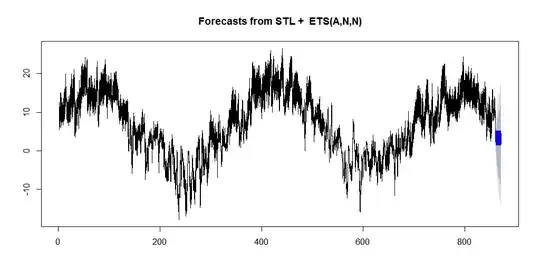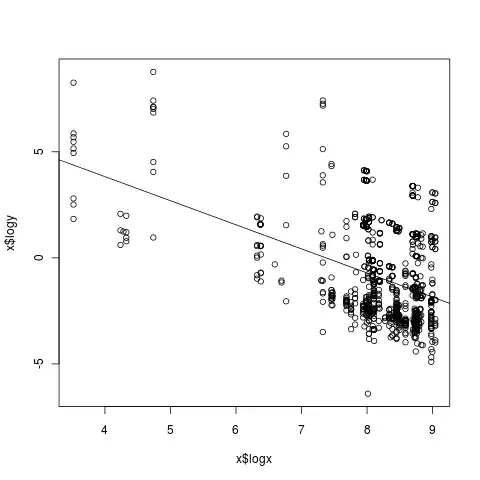I have hourly temperature data over a 5 year period with a lot of missing values. They have 2 seasonal periods: daily (24) and annual (365*24). I am very interested in the diurnal cycles of the temperature. Is it possible to forecast (or "backcast") the missing values, which are mostly 2000 values straight? Here is one of my datasets: http://www.file-upload.net/download-10551392/BaiMu.txt.html
Because I wanted to do a decomposition of my data and since decompose or stl doesn't handle missing values, I extracted a period of my timeseries without missing values: Station <- 2
TMP <- which(!is.na(BaiMu[,2]))
Station <- BaiMu[min(TMP):max(TMP),c(1,Station)]
Station <- Station[23509:length(Station[,2]),]
Then I tried a simple forecast:
Station.ts <- ts(Station[,2], start=c(1,1+as.numeric(format(Station[1,1], "%H"))),
frequency=24)
require(forecast)
plot(forecast(Station.ts, h=240))

The forecast obviously didn't work. What did I do wrong?
Next I tried an auto.arima forecast:
Station.arima <- auto.arima(Station.ts)
plot(forecast.Arima(Station.arima, h=240))
That took a very long time and then also didn't work. Is there any way to forecast hourly time series up to 2000 values in R? How can I estimate the missing temperature values with R using the values before the gap and after it?
I also have temperature data from loggers nearby. Maybe I could estimate the 2 seasons and the trend of both time series (missing-value-logger (A) and non-missing-value-logger nearby (B)), then find out the random component of the B in the time period of the missing values of A and then add the seasonal components and trend of A to the random component of B. I tried decompose(), first with the daily season, and then removed the seasonal components:
Station.dec <- decompose(Station.ts)$figure
Station.seas <- rep(Station.dec, 1+length(Station.ts)/24)[1:length(Station.ts)]
plot(decompose(ts(Station.ts-Station.seas, start=c(1,1+as.numeric(format(Station[1,1], "%H"))), frequency=365*24)))
 But the decomposition with decompose didn't show good results, because there was no random component (for A) but only season and trend. I think that's not possible because there always has to be a random component. Is that right? How I could use a sine and cosine equation to represent the seasons?
But the decomposition with decompose didn't show good results, because there was no random component (for A) but only season and trend. I think that's not possible because there always has to be a random component. Is that right? How I could use a sine and cosine equation to represent the seasons?
To summarize my questions: 1) Is it possible to forecast and/or backcast hourly time up to 2000 values? How could I do this?
2) How can I calculate and remove the seasonal components for an hourly time series with 2 seasons (daily and annual)? Is there any R function to do this?
I would be very thankful for any help, because I am relatively new to time series statistics.